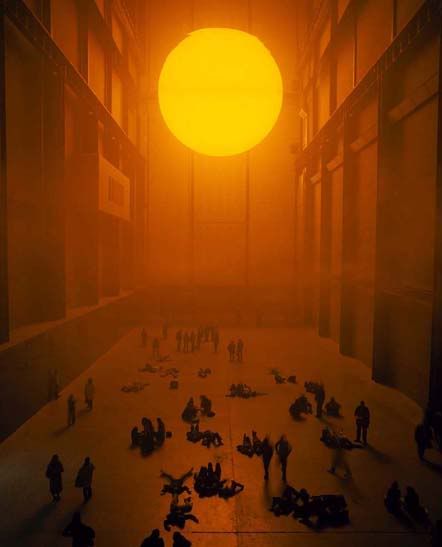
Olafur Eliasson - The Weather Project (2003)
“How are you doing?”
I opened my eyes to see Pete standing above me , packing away his camera.
“Fantastic thanks. “ I said. “You get any good shots?”
“Well I’ve taken tonnes, should have a couple of good ones. Did you see that lot?”
He pointed towards a group of teenagers who were lying flat on their backs in a circle, legs splayed and feet touching. They cheered at the star they’d created on the mirrored sky above them.
Around us children ran in circles, squealing with joy as their parents sat quietly smiling and watching their offspring’s delighted confusion. Club goers, commuters, tourists and Southwark locals sat in groups chatting quietly in the intense yellow light or stood gazing through the mist at the vast disc of light that seemed to hover above us.
Olafur Eliasson’s installation The Weather Project had really caught the public’s attention and imagination, over the weeks that followed it’s unveiling, friends who worked in the area talked of lunchtime trips to Tate Modern during the week ‘to get a bit of sun’ It was a work that somehow created a community of its own around itself by creating an odd little bubble of unreality in which encounters could take place. As vast and technically breathtaking (as an example of electrics and engineering) as it was, it transformed and dominated the Turbine Hall not by occupying and subordinating it – as Anish Kapoor’s Marsyas had a year previously, but by changing the nature and environmental qualities of the space.
Using as familiar a subject as a sunset, I think, also explained the works popularity. It’s a subject we’re all familiar with from holiday snaps and children’s TV art programmes (I seem to remember that the late great Tony Hart would teach us how to make at least one sunset per series of Take Hart.) In the real world it something we’ve all experienced and it appeals to something primal inside us; the end of the day, the dying of the Sun God, the sublime – however you want to frame it. As a retreat from the grey, damp and dismal London weather, it felt like a grand Romantic gesture – a technological updating of works like Frederic Edwin Church’s Cotapaxi that had hung in Tate Britain a few months earlier as part of a show celebrating 19th Century American landscape painters.
But for all the play and fun it brought out in the visitors, there was a perhaps a more Apocalyptic aspect to the work. The monotone lamps obliterating every colour in the room apart from the all pervading sickly yellow gave the space a distinctly alien feel, for all its technical wizardry it felt old and dying, a natural phenomena taken from somewhere else and frozen in a gallery as a museum piece. To my mind, drenched in science fiction as well as art history, I couldn’t help thinking of the 1972 film Silent Running, where the last remaining plant specimens of a dying earth are jettisoned into space. Viewed in the context of Climate Change could The Weather Project be a glimpse into a future where the only place we could experience a sunset would be in a museum, or maybe a society where the only weather we would have would be artifical? I imagined that the people around me would soon leave to walk down gleaming white corridors of a 2001 style space station or some colony base on an inhospitable world to sterile living quarters where they’d dine on protein pills and filtered water. To my mind the work now seemed like a meeting between John Martin and J.G.Ballard.
Perhaps I was being too pessimistic, perhaps if anything The Weather Project suggested that humans will always respond to natural beauty and that we’ll always find a way to take it with us whether it’s a photograph or a vast installation. Perhaps my imaginary future folk had created this as a reminder of home, not as a memorial to it.
“Hello. Planet Earth calling.”
I shook myself out of my geeky reverie.
“Sorry – miles away.”
“Come on, lets go.”
We wrapped our coats tight around us and walked out into the driving autumn rain on the darkening South Bank.
“Of course” said Pete “It could have done with some robots..”

No comments:
Post a Comment